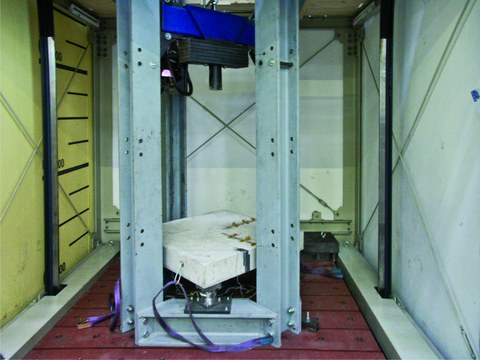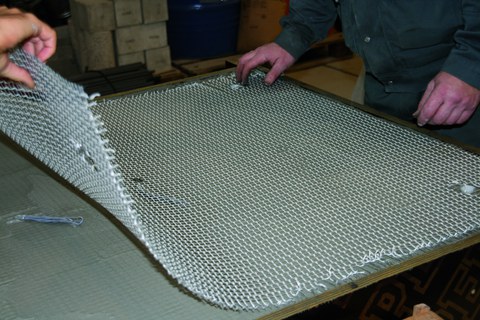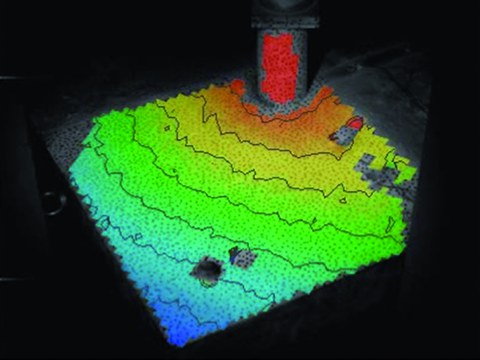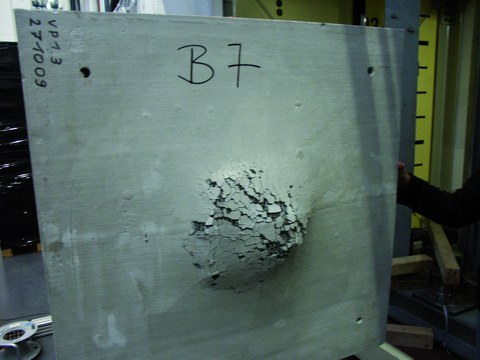Concrete under impact loading
Table of contents
Project data
| Titel | Title Beton unter stoßartiger Belastung | Concrete under impact loading Förderer | Funding Institut für Massivbau, TU Dresden Zeitraum | Period 08/2009 – 12/2011 Leiter | Project manager Prof. Dr.-Ing. Dr.-Ing. E.h. Manfred Curbach Bearbeiterinnen | Contributors Dipl.-Ing. Anja Hummeltenberg, Dipl.-Ing. Birgit Beckmann |
Report in the yearbook 2011
Concrete slabs under impact

Drop tower facility at the Institute of Lightweight Engineering and Polymer Technology
The mechanical behaviour of concrete structures depends on the loading velocity. An impact load such as rock fall or vehicle impact has different effects than static load. To investigate this, 15 concrete slabs made of standard concrete C20/25, high performance concrete HPC and ultra-high performance concrete UHPC with and without a subsequently added textile strengthening layer were tested in a drop tower device. Many measurement techniques were used for the data acquisition of local as well as global slab behaviour.
First, the pure impact resistance and a potential protection effect were in focus, i.e. the question „Does the slab withstand the impact or is it entirely perforated by the impactor?“ It turned out, that the slabs made of standard concrete and of HPC did not withstand the impact load. This occurred independently of the drop heights tested. On the contrary, the textile-strengthened slabs and the UHPC slabs withstood the impact load. They were locally damaged but not entirely perforated by the impactor. For this reason, the use of a textile strengthening layer and/or UHPC is an effective protection measure against impact and can be recommended for use in rock fall galleries, for example.
In the present study, the analysis of the strains due to the impact load was in focus. The concrete strains were detected in different distances from the impact centre at the top of the slab, and the strains of the reinforcement steel were detected at the slab bottom. The measurement results show the temporal and local variation and the propagation of the impact-induced disturbance. The transition from the local to the global slab behaviour is visualized and differs for stirrup-reinforced slabs in comparison with all other slabs. Considering the strain of the reinforcement steel of the textile-strengthened slabs, a local delamination of the strengthening layer is seen.
There are hardly any differences in terms of strains and strain rates between the slabs of different concrete types. Also the strains of the textile-strengthened slabs are in the same range as the ones of the slabs without textile reinforcement. This points out, that the local peaks in tension strain occur at a time, where the question, whether the slab withstand the impact or not, is not yet answered.
Report in the yearbook 2010
How do concrete slabs behave under rock fall load?

Application of steel fabric reinforcement
The behaviour of materials and structures under impact load differs from the one under usual static load. In this project, load cases as vehicle impact or rock fall are considered.
At the Institute of Concrete Structures, impact experiments are conducted using the drop tower facilities of the Institute of Lightweight Engineering and Polymer Technology of the TU Dresden. Varying the velocity up to 47 km/h, a drop mass or impactor is dropped onto differently reinforced concrete slabs. Beside the analysis of the measurement results, another point is the qualitative evaluation, to what extent concrete slaps can resist impact load and act as protective measure against rock fall, for example. Two of the tested slabs were sawn through after the test procedure to gain an insight into the interior of the damaged concrete slabs.
What did we observe? The experimental results show, that all slabs of standard concrete C 20/25 were completely punched through by the impactor independently from impact velocity. Actually such slabs of standard concrete, that had a higher shear capacity because of additional stirrup reinforcement in the area of the expected punching cone, were perforated by the impactor. The stirrups influenced the shape of the punching cone, but could not prevent entire perforation of the slab. Even slabs of high performance concrete C 70/85 could not resist the impact load. Compared with standard concrete, they showed a different fracture pattern, but actually they were punched through. In contrast, slabs with subsequent reinforcement of steel or carbon fabric showed a completely different behaviour. These slabs were only damaged, but not perforated. The embedded fabric obtains a membrane effect, which stops the penetration of the impactor and prevents an entire perforation of the slab. Using such a fabric reinforced slab in a rock fall gallery, for example, the range beneath the slab is protected against impact load.
Report in the yearbook 2009
Concrete under impact loading

Results: Slab deflection during impact
Local damage resulting from an accidental impact situation to a structure, e. g., vehicle impact to a building, may lead to the global load-capacity failure of the structure. In contrast to static loading, the structural response to dynamic loading includes force dependencies with both time and location, material inertial effects, and changes to material properties from changing strain rates.
The goal of this project is to investigate the reaction of concrete slabs of varying levels of strength and to evaluate the reinforcement of existing concrete slabs. The interaction between the local material reaction at the point of impact and the global reaction of the slab is one of the primary underlying interests of this research.

Results: The tension zone of a slab after impact
Experiments were conducted on different slab configurations in a drop tower at the Institute of Lightweight Structures and Polymer Technology (Institut für Leichtbau und Kunststofftechnik, TU Dresden). Different concrete strengths, ranging from normal strength concrete (C20/25) to ultra high performance concrete (UHPC), were tested. A number of slabs received a strengthening layer with carbon or steel fabric reinforcement. Both weight and height of the impactor were varied in this testing regime. For example, in one experiment, an 180 kg impactor was dropped onto the concrete slab at a speed of up to 47 km/h.
Several methods were used to measure strains; forces acting at the support points; acceleration of the drop mass; and deflection of the slab. The entire sequence was documented by two high-speed cameras in order to take photogrammetric measurements. Later, differences between pictures were evaluated and interpreted as the deformation of the specimen. A sample surface with a random black-white pattern is necessary for this evaluation.
